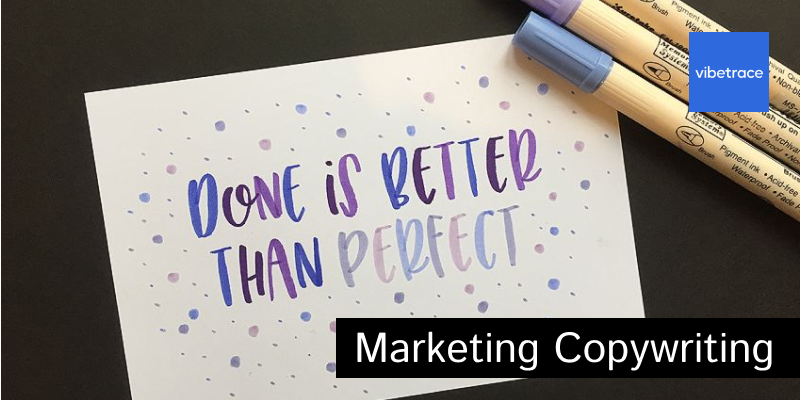Words are extremely powerful, especially in marketing.
Copywriting, a crucial aspect of advertising and promotions, involves crafting words with the intention of drawing people’s attention and making them take action.
It’s not just about writing whatever comes to mind; various factors must be taken into consideration to make an impact.
By definition, copywriting is the act of writing text for the purpose of advertising or other forms of marketing to persuade an audience to take a particular action, such as making a purchase, visiting a website, or requesting more information.
Why is Copywriting Important?
- it helps increase conversion rate. Having great texts entice people to click, purchase, therefor going doing through the funnel.
- it helps increase customer retention. Using personalization will help them come back to your business.
- it helps building your email list. Instead of having the same message to everyone, you can convince them to give you first their contact information.
Here are 5 things you have to learn about copywriting according to experts:
6 Types of Copywriting Angles You Can Use for Emails by Bryan Curly
According to Bryan Curly, a copywriter, there are six commonly used copywriting angles that can be effective in generating revenue for clients through email marketing.
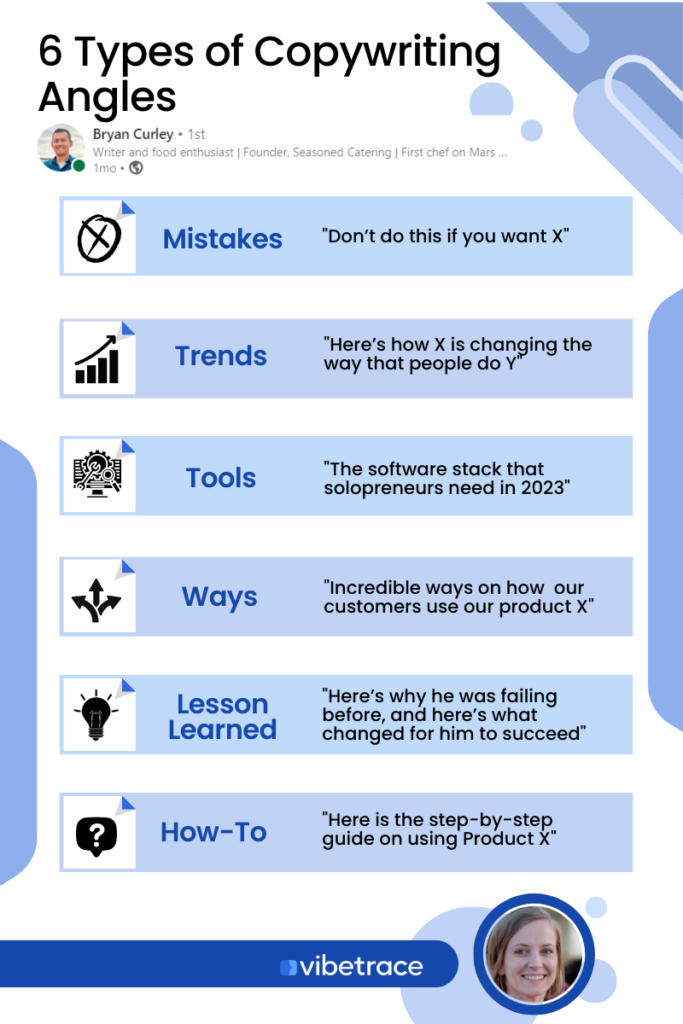
- Mistakes: By highlighting common mistakes people make and how to avoid them, you can demonstrate your expertise and provide valuable information that can help drive conversions.
- Trends: By showcasing current trends in your industry and how they are affecting customers, you can create a sense of urgency and interest in your product or service.
- Tools: By highlighting the software and tools needed by solopreneurs in 2023, you can demonstrate your knowledge of the latest technology and help clients see the value in your offerings.
- Ways: By showcasing real-life examples of customers using your product in unexpected ways to get great results, you can highlight the versatility and effectiveness of your offerings.
- Lessons learned: By sharing lessons learned from past failures, you can demonstrate your experience and help clients see the value in your solutions.
- How-to: By providing an explainer video or set-up guide, you can help educate clients on how to use your product or service and increase their likelihood of making a purchase.
It’s always important to find the copywriting angle that works best for your target audience and resonates with them.
Put the Readers First: A Fundamental Copywriting Principle by Jimmy Kim
When creating content for marketing and advertising purposes, it is crucial to keep the reader at the forefront of your mind. By putting the reader first, you can create content that is appealing and relevant to them, which in turn can help increase the chances of them taking action.
According to Jimmy Kim, CEO and co-founder of Sendlane, a cardinal rule in copywriting is to always prioritize the reader.
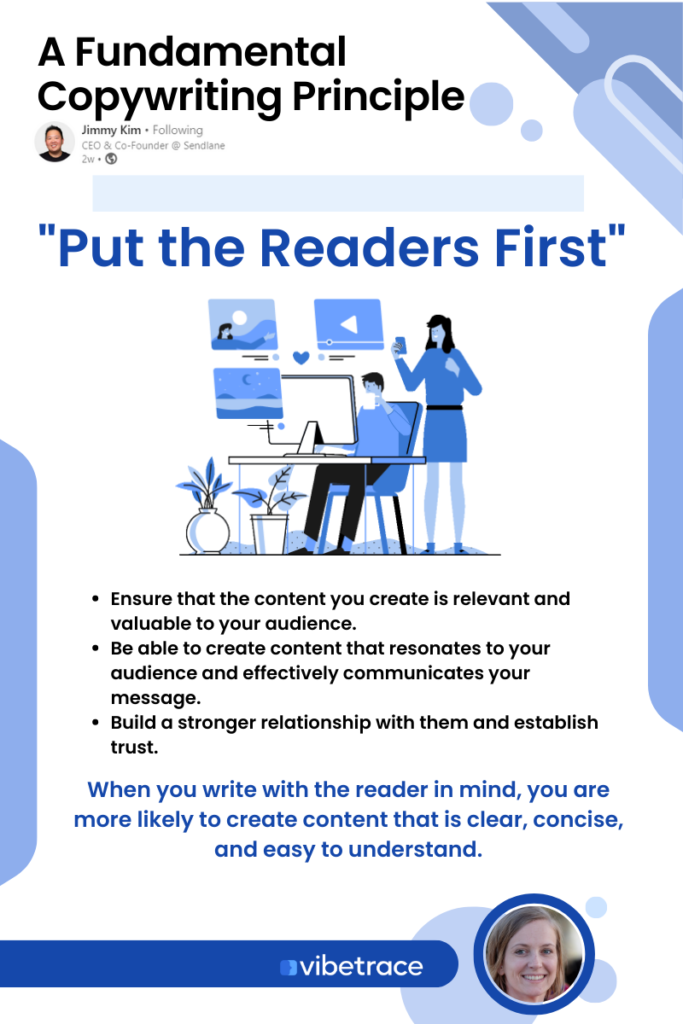
A Simple Copywriting Rule:
Focus on the reader, not the product.
Instead of saying: “Our new razors are 35% sharper.”
Say: “Effortlessly achieve a smoother shave with our newly improved, sharper blades.”
Frame the copy in a way that highlights the benefits to the reader, not just the product’s features.
Want to be up to date with Marketing?
Subscribe to our Retail CX newsletter!

Stay connected with what’s really important to optimize your digital revenues.
By clicking the button, you accept our Terms & Conditions. Also you will need to confirm your email address.
5 Best Copywriting Frameworks by Philip R.
Copywriting is an essential aspect of marketing and advertising, as it helps businesses communicate their messages effectively to their target audience. It is crucial to have a clear and concise message that can persuade the reader to take a desired action. However, coming up with the right words and phrasing can be challenging, especially when working on a tight deadline.
To make the copywriting process more manageable and efficient, several frameworks have been developed that can guide copywriters in crafting compelling messages.
Philip R., an email marketer, introduced in a post the 5 best copywriting frameworks that can help you create effective and impactful content. From frameworks that focus on creating a clear message to those that help you craft persuasive headlines.
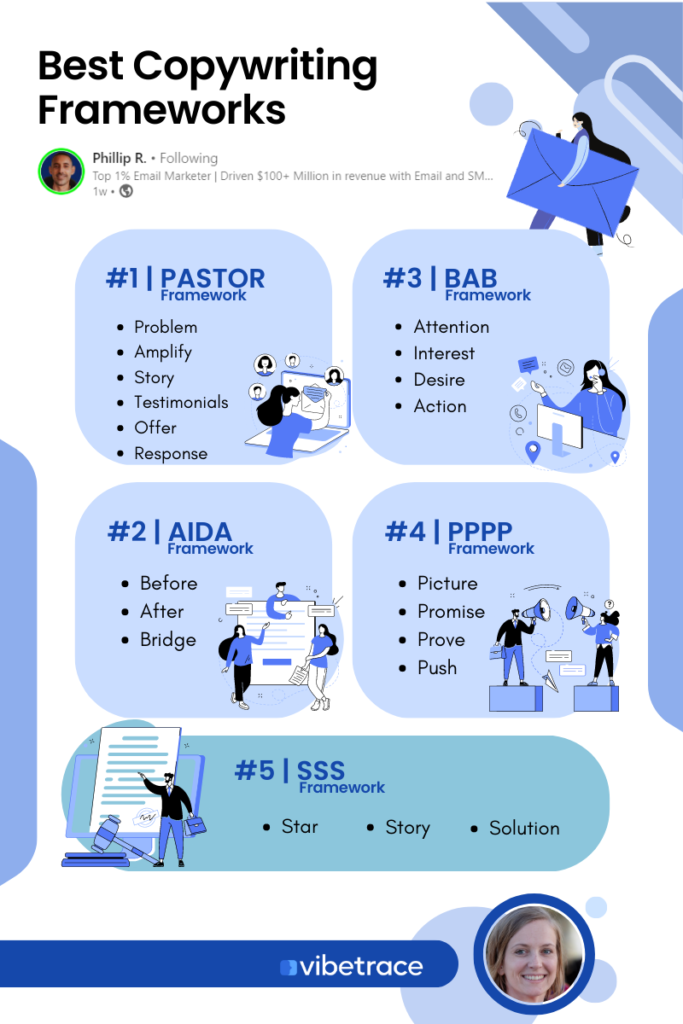
Whether you are a seasoned copywriter or just starting out, these frameworks can serve as a helpful guide in your copywriting journey.
- PASTOR – Problem, amplify, story, testimonials, offer, response.
The PASTOR framework is a popular copywriting framework that focuses on the following key elements:
- Problem: Start by identifying the problem that your target audience is facing.
- Amplify: Highlight the pain points of the problem and amplify the reader’s frustration.
- Story: Tell a story that your target audience can relate to, highlighting the problem and how it has affected people.
- Testimonials: Share real-life testimonials from satisfied customers who have overcome the same problem.
- Offer: Offer a solution to the problem, highlighting the benefits and unique features of your product or service.
- Response: Encourage the reader to take action by making an irresistible offer.
- AIDA – Attention, interest, desire, action.
The AIDA framework focuses on capturing the reader’s attention, arousing their interest, and creating desire for your product or service, with the ultimate goal of driving action. The framework is broken down into four elements:
- Attention: Start by grabbing the reader’s attention with a bold headline or an attention-grabbing opening statement.
- Interest: Keep the reader interested by highlighting the benefits and unique features of your product or service.
- Desire: Create a desire for your product or service by highlighting the positive outcomes that it can deliver.
- Action: Encourage the reader to take action by making a clear call to action.
- BAB – Before, after, bridge.
The BAB framework focuses on creating a narrative that highlights the problem the reader is facing, showcasing the positive changes that your product or service can bring, and making a clear connection between the two. The framework is broken down into three elements:
- Before: Start by highlighting the problem the reader is facing and the negative outcomes they are experiencing.
- After: Showcase the positive outcomes that the reader can expect after using your product or service.
- Bridge: Make a clear connection between the problem and the solution, highlighting how your product or service can help the reader overcome the problem.
- PPPP – Picture, promise, prove, push.
The PPP Framework is used to persuade readers by showing them how reliable a business is by showing enticing images, interesting promises, proof from previous users or current clients, and the best pitch to convince them.
- Picture: Include Images such as infographics, product/service images, and high quality photos that are related to your texts.
- Promise: Offer a promise that readers won’t be able o resists with a one time offering campaign.
- Prove: Gather all feedbacks from other clients that can make readers trust the quality of the products/service offered to them
- Push: Create the most persuasive pitch in few lines.
- SSS – Star, story solution.
The SSS Framework focuses on highlighting a problem that is presented by a story to promote the solution.
- Star: Begin with introducing the reader to the main character of your story who can be a customer or any fictional character.
- Story: Tell a relatable story that shows the main problem of your main character
- Solution: Highlight the solution you can offer to the problem.
The running themes between them include:
- Telling stories
- Solving problems
- Grabbing attention
- Proving your solution
When in doubt, use one of those.
Copywriting Guide for Emails by Chase Dimond
A well-written email can grab the attention of your target audience, build trust, and encourage them to take action. That is why copywriting is an essential aspect of creating an email. On the other hand, poorly written emails can damage your brand’s reputation and fail to deliver the desired results.
A copywriting guide or cheat sheet for emails is designed to help you create compelling and effective emails that drive engagement, conversion, and revenue.
The following is a cheat sheet for determining the types of emails your brand should send based on its annual revenue, according to Chase Dimond, a top email marketer. By following the best practices and tips outlined, you can ensure your emails are engaging, and impactful, helping you achieve your marketing goals.
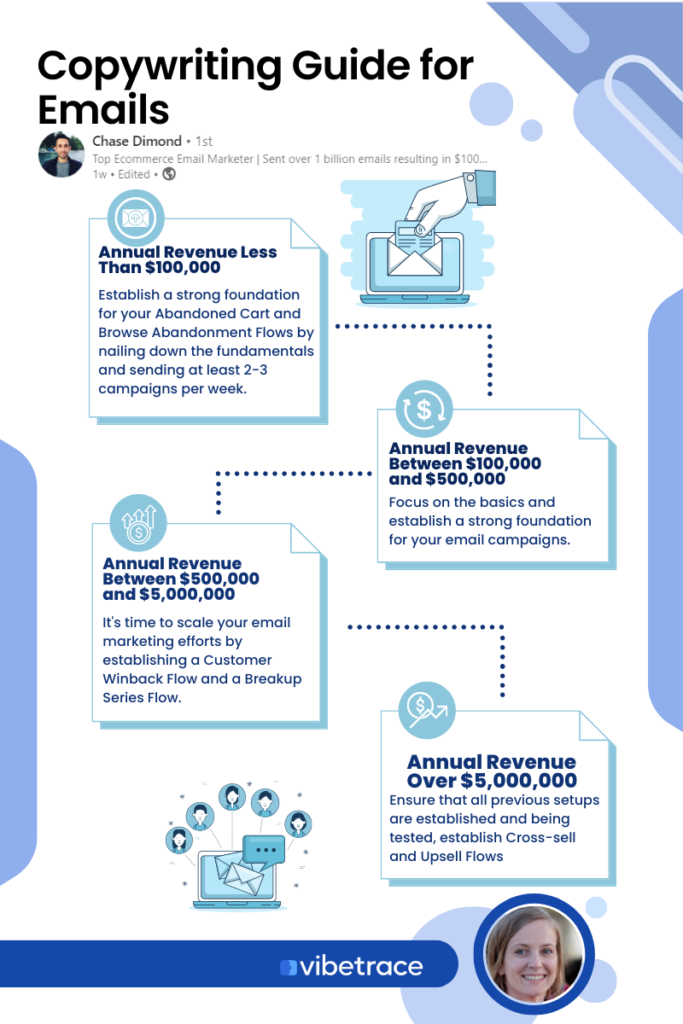
Annual Revenue Less Than $100,000
- Establish the following basic flows:
- 3 Welcome Series Emails
- 2 Abandoned Checkout Emails
- Customer Thank You Flow
- Send 1 campaign per week
- Focus on the basics, no need to get too fancy
Annual Revenue Between $100,000 and $500,000
- Establish the basic flows
- Establish Abandoned Cart Flow
- Establish Browse Abandonment Flow
- Send at least 2-3 campaigns per week
- Nail down the fundamentals
Annual Revenue Between $500,000 and $5,000,000
- Establish Customer Winback Flow
- Establish Breakup Series Flow
- Send at least 3-4 campaigns per week
- Consider hiring an email marketing agency
- It’s time to scale your efforts
Annual Revenue Over $5,000,000
- Ensure that all previous setups are established and being tested
- Establish Cross-sell and Upsell Flows
- Send at least 4 campaigns per week
- Consider hiring an email marketing agency or consultant
- Aim to make at least $1 million per year through email marketing.
Benefits of Writing Successful Emails
A post written by Srishti Kashyap, a Java Developer, highlights the importance of email as a means of communication. She explains that emails have many advantages over traditional mail, as they can include a variety of text, documents, and multimedia content such as photos and videos.
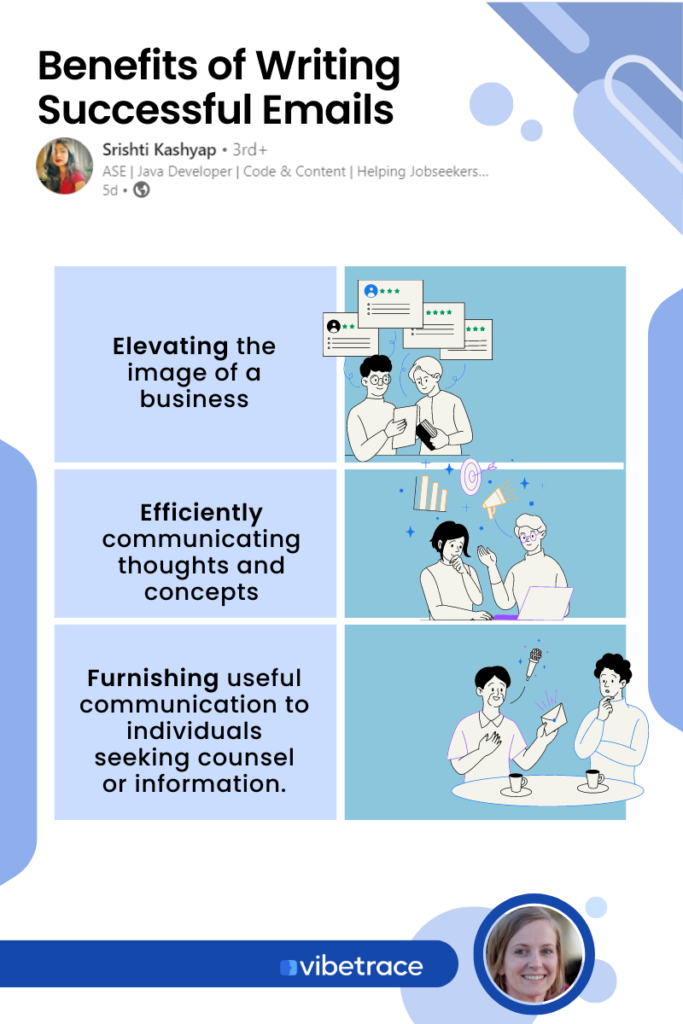
The post further emphasizes the benefits of writing successful emails, including:
- the ability to improve business reputation,
- effectively communicate ideas
- and provide valuable correspondence to those in need of advice or input.
Overall, this article sheds light on the crucial role that emails play in today’s fast-paced and interconnected world.

